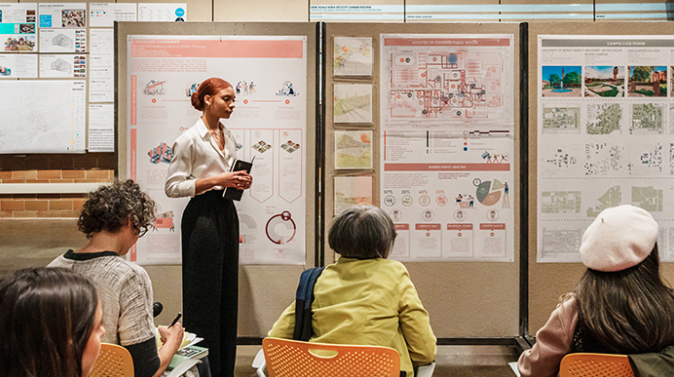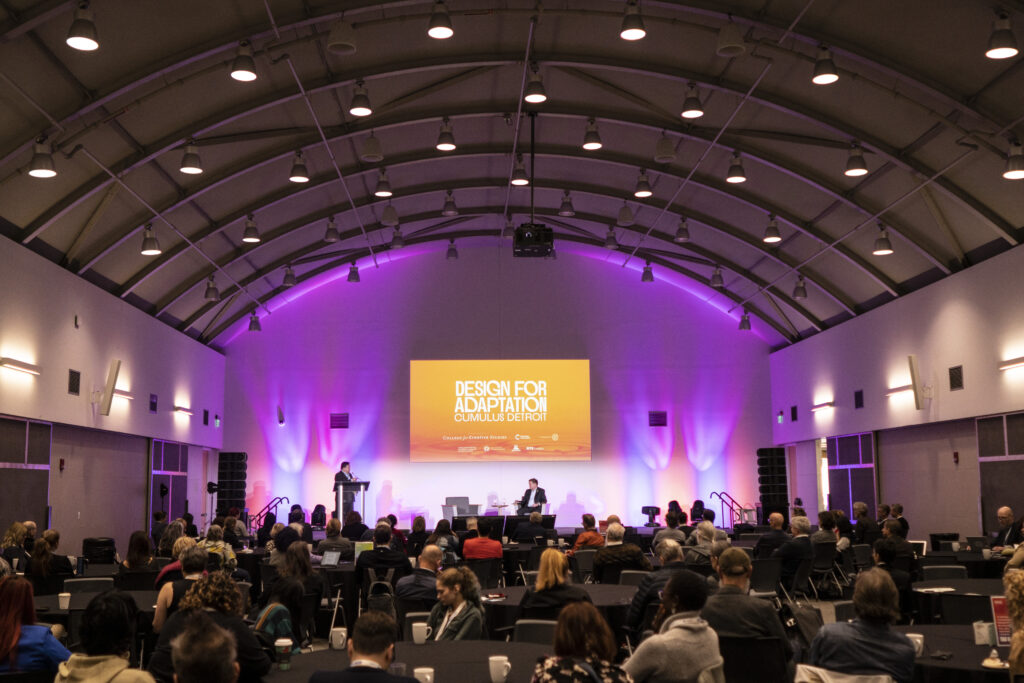UDM: Teaching Design Through Social Justice and Sustainable Communities

For nearly sixty years, the University of Detroit Mercy School of Architecture and Community Development has been educating designers and planners. The school is committed to preparing students to address urban revitalization, environmental justice, and sustainability, and through its design studios, Master of Community Development, Detroit Collaborative Design Center, and international studies program, offers real-world experience. Dean Dan Pitera talked to SBN Detroit about the school’s approach to preparing students for the practical applications of sustainable design. Q: What can you tell us about the community development aspect of the school? A: If we take a child who is enrolled in a poorly designed and unmaintained school and then put that same child with the same faculty in the same neighborhood in a well-designed school, the child will be nurtured and developed differently. The space around a child – a person – is important. The spaces we are in influence how we are as people just like nutrition influences health and wellbeing. So why aren’t our communities designed differently? And from a school perspective – how do we teach that? We ingrain community development through the lens of social justice throughout our curriculum, and we start on day one of the program. For example, within a Structures course we embed these concepts, so students begin to see that whether they are designing a museum or affordable housing, all designs should be looked at through this lens. Q: The school is internationally recognized for its environmental justice-driven and student-centered approach. Talk about this approach and how it’s different. A: We help students understand that climate change and climate justice are linked. We sit in the Great Lakes region with Michigan at the center. Our buildings and our communities must be prepared and designed for climate migration, so our students must obtain hands-on experience. Q: You led the Detroit Collaborative Design Center for years. Is this center unique when it comes to design schools? A: Only a handful of architecture schools have something like this. I modeled it after the medical field, where teaching hospitals align with and collaborate with medical schools. The DCDC is a true architecture office within the school of architecture. It works exclusively with nonprofit organizations and government agencies. There, students get paid to work, and they work with professional architects, urban designers, and landscape architects. It is essential to take theory and practice and bring them together. Q: How do you prepare future generations of architects and planners to think sustainably throughout their careers? A: We’ve been teaching this way for a long time. Now, the students coming in want education around sustainability and that’s exciting for us. I think the most effective way to teach is not class by class, but through concepts that are continually woven throughout the curriculum. The concepts of social justice, climate change, and building sustainable communities are woven throughout every class and we start on day one, as I mentioned previously. I teach Introduction to Architecture to first-year students, and I introduce the United Nations development goals. I teach that architects essentially create 40% of greenhouse gases produced annually. The emissions come not just from the buildings themselves, but the materials used to build, and the processes taken to create these materials. Students come in thinking in terms of brick-and-mortar buildings, and we teach them immediately about the impacts on the environment and the communities around the buildings. We have a Zoning and Codes class in which students learn about redlining, deed restrictions, and blockbusting. Most professors at other schools are not teaching this. So, the students are learning and digesting these things constantly throughout their five years. Q: What do you think your graduates take out into the workforce that’s different? A: The ability to adapt to change. The program they are working with now to design lighting or a certain type of heat will likely not be the same program in four years. Things change fast. I asked my students in the fall of 2022 if they thought we’d be using AI going forward. They laughed. At the start of 2023, I asked them what tools we as architects would be using, and they all said AI. So, we work with the tools we have today but also train the students to be flexible and adaptable. They will need these skills to design and also to sustain their careers and lives. Be sure to subscribe to our newsletter for regular updates on sustainable business practices in and around Detroit.
Cumulus Holds Global Design for Adaptation Conference in Detroit

Cumulus, a global association of art and design education and research, held its annual conference, Design for Adaptation in Detroit Nov. 1-4 at the College for Creative Studies. This marks only the second time in its 30-year history that the conference was in North America. Cumulus connects 350 member institutions across 63 countries to exchange knowledge and best practices to elevate the positive role of designers and artists in creating sustainable and humane futures for all. “If there is one thing we know, we are stronger together,” said Terry Barclay, SBN Detroit Chair and CEO of Inforum, in a Thursday afternoon welcome address. “I think we have a common sense of urgency to break down silos that slow collaboration and this conference is certainly about that.” SBN Detroit was a conference sponsor. “This international conference has such diverse participation,” said Neil Hawkins, president of the Fred A. and Barbara M. Erb Family Foundation, who moderated a keynote address. We have creative designers hoping to change the trajectory of climate disasters. We have local Detroit leaders demanding justice for people already suffering impacts. We have great minds from all corners of the earth here in Detroit, which in many ways can be called ground zero for the climate crisis.” To that end, he noted that metro Detroit has endured serious local flooding from three 500-year rainfalls in the last ten years, holds 25% of the world’s surface freshwater in the great lakes, and the state is fittingly named after a natural resource – Michigan meaning “big lake.” Ian Lambert, co-chair and submissions chair for Cumulus 2022 and also dean of graduate studies at the College for Creative Studies, said, “As the only UNESCO-designated city of design in the U.S., Detroit has an incredible history of makers and manufacturing and design, so it’s fitting that Cumulus was held here. And it’s huge for Detroit.” The conference – focusing largely on the issue of climate change, automation, and income inequality – explored the role designers play in fostering adaptation through a wide range of approaches, methods, visions, and experiments. In that vein, the mission is to think ahead to catalyze ideas to reduce vulnerabilities and foster resilience for communities. Noting that the world is 1.2 degrees Celsius warmer than at any point in human civilization and that 300 billion tons of carbon have been added to the atmosphere by humans, keynote speaker Mikko Ollikainen, head of the Adaptation Fund, said to the audience of designers, “You are the minds to shape the future and you have your work cut out for you. … “We are facing an increasing arrival of uncertainty and must be prepared for things we do not expect and prepared to withstand shocks.” Land use and its relationship to climate change and inequity were the focus of several panels. Anika Goss, CEO of Detroit Future City, said in her keynote, “When we look at the cities in Detroit and around the world that are hit hardest by climate change, it’s always the poorest and the brownest neighborhoods.” She pointed to a community on the lower east side that suffered stormwater flooding as an example, saying, “From an economic standpoint these families continue to lose value in their homes and property simply because they live in a neighborhood with poor infrastructure.” The Eastside Community Network is working to put residents in charge of enhancing their neighborhoods toward resiliency. President Donna Given referenced its LEAP Sustainability Fellowship saying, “When you give someone a small amount of money and the responsibility to build a better space it’s amazing what that can do to a neighborhood.” The fellowship is a training and development program where fellows develop community projects, apply for grant funds to support them, and then implement them with the help of the community. To that end, Jerry Hebron, executive director of Oakland Avenue Urban Farm, shared her story of growing up near Motown in its heyday, leaving the city, and then returning in 2005 to find it riddled by crime and decayed. She became an activist and was charged to find out what needs the community had. “I knocked on doors to collect information and found that housing and food were the residents’ most important needs.” The high vacancy rate and open land equaled opportunity. The community wanted a garden and they built one – 20×20 feet. Today, 14 years later, they are farming 3.5 acres, a farmers market, youth programming, and more. “The community reclaimed that land and worked together to change their neighborhood.” Linking this back to design, Lambert and Leslie Tom, chief sustainability officer at the Charles H. Wright Museum of African American History, presented a collaboration involving the repurposing of three dying trees on the museum’s property. Instead of letting the trees end up in a landfill, The Wright and the Center for Creative Studies repurposed the trees and created a curriculum around co-design for sustainability, climate justice, and African American material culture, out of which came a narrative around how two neighbors – a museum and an art school – set a precedent for climate justice art. “One of the pieces a student created spoke to land use in Detroit by combining window panels from an abandoned home and the repurposed timber to tell the story of decay and rebuild,” Lambert said. There is no doubt that the complex consequences of climate change have pushed the need for community resilient strategies to emerge and thrive in the face of change. About the role designers play in this, Ollikainen said, “How designers see the world and work has a profound impact on building sustainable solutions. You have the vision, and you have the skills to turn that vision into reality.” Be sure to subscribe to our newsletter for regular updates on sustainable business practices in and around Detroit.


